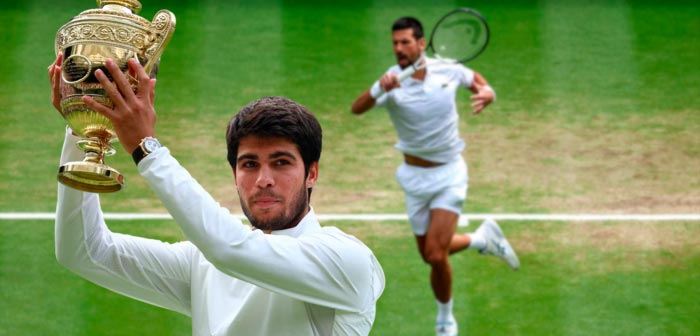Carlos Alcaraz’s electrifying forehand has taken the tennis world by storm even before his arrival at Wimbledon. The buzz surrounding the young Spanish player has spread like wildfire from the nearby Queen’s Club, where he recently secured a remarkable victory. Not since Boris Becker’s unforgettable breakthrough in 1985 has a Queen’s champion captured the tennis community’s attention with such force, reigniting discussions and hopes for a more competitive era.
Those fortunate enough to witness Alcaraz’s performances in the pre-Wimbledon tournament were left in awe of his blistering forehand, which sailed across the net and scorched the grass courts. Bold claims have been made, suggesting that Alcaraz possesses elements of both Federer and Nadal in his game. Some even believe that he possesses the potential to excel on clay like Nadal while showcasing a well-rounded grass-court prowess.
Andrew Castle, a former British No.1 and a prominent figure in tennis commentary, boldly declared, “I could see Alcaraz winning Wimbledon, 100 percent.” Such unwavering confidence is a rarity, especially considering the undeniable dominance of Novak Djokovic, the four-time defending champion at Wimbledon and widely regarded as the greatest of all time.
What transpired at Queen’s Club that has instilled the belief that Alcaraz could be a formidable contender against the established elite? Prior to the grass season, Alcaraz had endured a somewhat disheartening end to his French Open campaign, which garnered widespread attention. While sympathy for his plight was prevalent, skepticism also loomed. In the French Open semifinal, a defining moment in his young career, Alcaraz had faltered against Djokovic. After two intense sets on clay, his intensity wavered, and he ultimately succumbed to the pressure.
Tennis legend John McEnroe, who commentated on the Champion vs. Challenger matchup in Paris, sensed that the impact of Alcaraz’s defeat extended beyond physical limitations. A week later, while delivering a speech at Stanford University’s Graduation Day, Alcaraz’s name resurfaced in McEnroe’s thoughts and words. Reflecting on the French Open, McEnroe shared, “There was Carlos Alcaraz, a kid younger than most of you, ranked number one in the world… he completely froze. The pressure became too much. I thought this could be life-altering for him.” Nevertheless, McEnroe expressed his belief that Alcaraz would bounce back, emphasizing the need for the young player to conquer pressure—an obstacle McEnroe himself had faced.
Now at Wimbledon, Alcaraz has acknowledged the lessons learned from his defeat in Paris, vowing that his next encounter with Djokovic will be different, with improved handling of pressure. As he secures straight-set victories in the opening rounds at Wimbledon, the focus remains on his formidable forehand. However, facing Djokovic will present a true litmus test for the young Spaniard. Despite the challenge ahead, signs of Alcaraz’s potential to disrupt the status quo are becoming increasingly apparent.
As the tennis world eagerly awaits the matchup between Alcaraz and Djokovic, spectators and analysts alike ponder the potential for a changing of the guard and a revitalization of the sport’s competitiveness. With his explosive forehand and newfound determination, Alcaraz embodies the hope for an exciting future in tennis.

